https://youtu.be/eBeGON0GyCw
openminds.tv
Open Minds Magazine #1
The Beginning: UFOs Encounters over Washington D.C.
Welcome to Open Minds Magazine. In this new monthly UFO news magazine show (view above), we will take a closer look at the mystery posed by Unidentified Flying Objects, in hopes to gain a better understanding of the nature of the phenomenon and how the government, including the military, and the public react to it.
Perhaps the most thorough examination into the UFO issue was conducted by the U.S Air Force. They began their investigation in 1948. It was called Project Sign, then changed its name to Project Grudge, and finally changed its name once again to Project Blue Book.
As for the results, the Air Force states:
As a result of these investigations and studies and experience gained from investigating UFO reports since 1948, the conclusions of Project BLUE BOOK are:(1) no UFO reported, investigated, and evaluated by the Air Force has ever given any indication of threat to our national security;(2) there has been no evidence submitted to or discovered by the Air Force that sightings categorized as “unidentified” represent technological developments or principles beyond the range of present-day scientific knowledge; and(3) there has been no evidence indicating that sightings categorized as “unidentified” are extraterrestrial vehicles.However, upon closer examination of the thousands of files released regarding the Blue Book investigations, it becomes apparent that the Air Force’s conclusions were not shared by everyone involved in the investigation, and that there were some truly fascinating cases that remain unsolved.
Often people say they will not believe in UFOs until they land on the White House lawn. Well, one of the most famous and mysterious Blue Book cases came close.
UFO sightings over Washington, DC in July 1952 made worldwide headlines and left the U.S. Air Force dazed and confused. The events spanned several days and included multiple radar identifications of unknown aircraft, some of which were correlated by witnesses on the ground. Many of the sightings caused the air force to scramble jet fighters, and in each of these cases, the UFOs outmaneuvered the jets. This all culminated into what may be the most important official U.S. Air Force UFO investigation of all time.
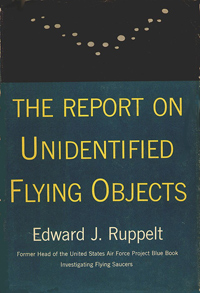 The
U.S. Air Force’s investigation of the events in Washington, DC is best
explained in a book written by the lead air force investigator, Captain
Edward Ruppelt. Ruppelt—who was the head of the U.S. Air Force’s
official UFO investigation department, Project Blue Book, from its
inception in early 1952 until late 1953—published The Report on Unidentified Flying Objects in 1956.
The
U.S. Air Force’s investigation of the events in Washington, DC is best
explained in a book written by the lead air force investigator, Captain
Edward Ruppelt. Ruppelt—who was the head of the U.S. Air Force’s
official UFO investigation department, Project Blue Book, from its
inception in early 1952 until late 1953—published The Report on Unidentified Flying Objects in 1956.The summer of 1952 was a busy time for the Blue Book investigators; Ruppelt referred to this period as, “The Big Flap.” Some of the most credible reports were coming from the Washington, DC area.
On July 10, a National Airlines crew reported a UFO over nearby Quantico, Virginia. They described the object as, “too bright to be a lighted balloon and too slow to be a big meteor.”
Then, on July 13, another commercial airline crew reported a UFO sixty miles southwest of Washington, DC. The crew was flying at 11,000 feet when they spotted a light below them. The object came up to their level, and when they turned on their headlights, it shot up in a steep climb.
The next day, on July 14, yet another commercial airline crew reported a UFO. This time it was during a flight from New York to Miami. While flying in the area of Newport News, Virginia, approximately 130 miles south of Washington, DC, the crew reported seeing eight UFOs.
Two days later, on the night of July 16, at around 9:00 p.m., a “high-ranking” scientist from the National Advisory Committee for Aeronautics Laboratory at Langley Air Force Base reported seeing a UFO with a friend. They were standing near the ocean when they saw two amber-colored lights off to their right. The lights were silently moving to the north. The scientist said they were “much too large to be aircraft lights.”
Ruppelt and his investigators had decided that this object would have been too big to be a plane given the description of the lights, and they could not find an answer as to what the scientists and his friend had seen. Ruppelt said it was a moot point, however, because the scientist “was a very famous aerodynamicist and of such professional stature that if he said the lights weren’t airplanes they weren’t.”
On July 20, Ruppelt was flying to Washington, DC on unrelated business. His plane landed at Washington National Airport in the morning, and he grabbed a paper to catch up on the latest news. There he found in big, bold, capitalized font, “INTERCEPTORS CHASE FLYING SAUCERS OVER WASHINGTON, D.C.”
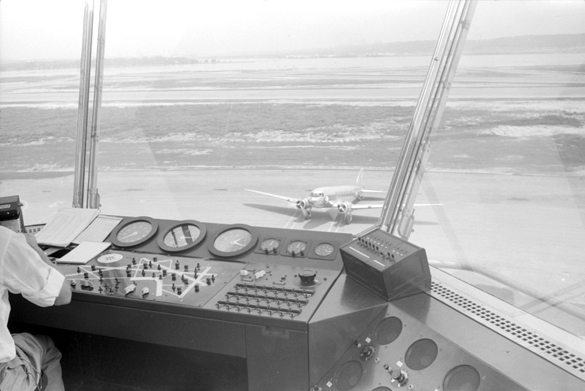
Washington National Airport control tower. (Credit: Jack Delano/Library of Congress/Wikimedia Commons)
The targets appeared to have flown near commercial airliners, and soon thereafter reports of strange lights were being reported by pilots. The first sighting from a pilot was from a Capital Airlines flight leaving Washington National Airport. The control tower asked the pilots of that airplane to keep an eye out for strange lights. During the flight, the pilot yelled, “There’s one—off to the right— and there it goes.” The radar correlated that an object had been tracked on the plane’s right side. The pilot reported seeing six more lights in the next fifteen minutes.
Several similar incidents took place that night. However, one of the more notable incidents was when the Washington National Airport traffic controller called the Andrews Air Force Base tower to tell them they were tracking an object south of the base. The tower operators looked out of their windows to see what they described as a “huge fiery-orange sphere” hovering in the sky.
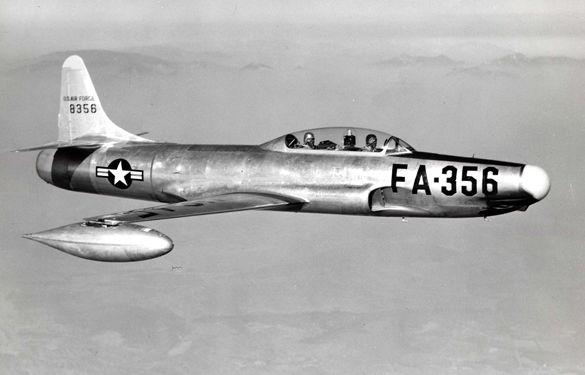
F-94 Starfire. One of the types of jets scrambled to intercept the unknown objects. (Credit: United States Air Force)
The events and the subsequent press coverage sent the U.S. Air Force into a state of pure confusion, complicated by bureaucratic bumbling. It was decided that Ruppelt would stay in Washington, DC to further investigate and formulate a response for the press, who was growing steadily impatient with the air force’s official “no comment” response. However, the USAF finance department would not improve the extension to his stay and sent him home.
Back in his office in Dayton, Ohio, Rupplet says he was too swamped with other UFO sightings to investigate the Washington DC incident. Several of these sightings also included jets being scrambled to check out the UFOs.
Then, exactly one week after the first major Washington, DC event, at about 10:00 p.m., Ruppelt received a call from Life Magazine’s UFO expert asking what the air force was going to do about that night’s UFOs. Ruppelt said, “I have no idea what the Air Force is doing; in all probability it’s doing nothing.”
He had heard anything about a new UFO event and guessed no one else in the air force had either. He called air force intelligence and the Pentagon, and he found out he was right. Several people from the Pentagon hurried out to Washington National Airport including the air force’s press chief Al Chop, Major Fournet, and a U.S. Navy electronics specialist assigned to the U.S. Air Force Directorate of Intelligence. All of them had a front row seat to the evening’s spectacular performance.
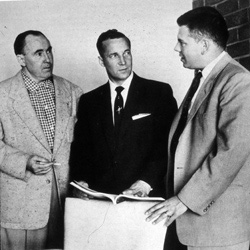
From left: Fournet, Chop, and Ruppelt.
At 11:30 p.m., it was decided to call in interceptors to check out the objects. Again they were slow to respond, but two Lockheed F-94 Starfires were in the air by midnight. At this point, reporters and photographers were asked to leave the radar room.
Ruppelt says the radar room was cleared because some of the air force officers thought this might be the night they got a good up-close look at a UFO.
Visibility that night was good. However, when the jets approached the targets, the objects disappeared from the radar screens. The jets returned to their base; however, a few minutes later, strange lights were seen near Langley Air Force Base. The lights were described as “rotating and giving off alternating colors.” The radar tower operators also saw the lights, so they called in an F-94 jet to check it out.
The jet pilot spotted the UFO’s lights and began moving towards it when the light disappeared. The pilot continued to fly around the area, and achieved a radar lock on an object, but whatever it was sped away. The same thing happened two more times.
Soon after the events near Langley Air Force Base, objects were again observed above Washington National Airport. Jets were scrambled again, but this time the objects stayed on radar as the jets approached. The tower controllers gave the jets the coordinates of the objects, but each time a jet closed in the objects would speed away.
This interaction continued for a few minutes until one object did not speed off. The F-94 pilot saw a bright light and hit his afterburners to try to pursue the object. However, as he got closer, the light just disappeared, and he could not get anything on his radar set.
The jets stayed in the area for twenty minutes, but finally ran low on fuel and had to return to the base. Dawn began to break, and soon the targets all disappeared.
The next day the press reported that fighter pilot, Lieutenant William Patterson, said,
I tried to make contact with the bogies below 1,000 feet, but [the radar controllers] vectored us around. I saw several bright lights. I was at my maximum speed, but even then I had no closing speed. I ceased chasing them because I saw no chance of overtaking them. I was vectored into new objects. Later, I chased a single bright light which I estimated about 10 miles away. I lost visual contact with it about 2 miles.Ruppelt was informed that “everybody in the radar room was convinced that the targets were very probably caused by solid metallic objects. There had been weather targets on the scope too, he said, but these were common to the Washington area and the controllers were paying no attention to them.”
The papers were once again packed with headlines about the UFO chase. Ruppelt flew to Washington, and when he got to his hotel he was mobbed by reporters and photographers. With the help of a colleague he pushed his way to an elevator without making any comments.
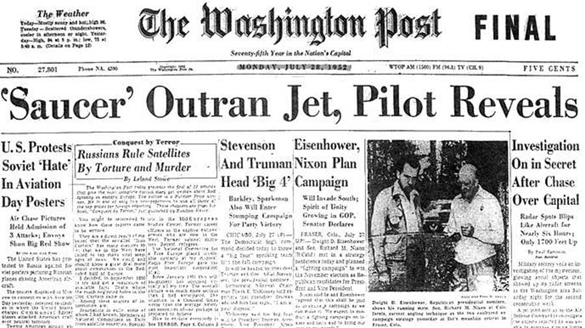
According to Ruppelt, the U.S. Air Force was in a state of confusion. They all agreed that the UFO event should be investigated, but no one actually did anything about it. Unable to dodge the public’s fascination with the Washington events, on July 29, Major General Samford notified the press that he would have a press conference on the Washington UFO incidents. Ruppelt felt it a bit odd that none of the men in the radar room at Washington National Airport were involved in the press conference. Instead, the press conference was held by Major General Samford and another officer, neither of whom had been fully briefed.
Samford told the press that the UFO investigations had turned out to be mostly misidentifications, but that the other twenty percent of the reports that came in were from “credible observers of relatively incredible things.”

Edward Ruppelt (standing center) at July 29, 1952 Pentagon UFO press conference. Also pictured, Major Generals Roger Ramey (seated left), USAF operations chief, and John A. Samford (seated right), USAF director of intelligence. (image credit: Wikipedia) He said the air force would continue to investigate those reports, but they suspect that the Washington, DC events may have been false radar readings due to temperature inversions.
According to Ruppelt, the actually investigation ruled out temperature inversions. In fact, he discovered that every single night of the UFO sightings in Washington, DC, there was indeed a temperature inversion but none of these had previously been mistaken for UFOs.
Ruppelt also discovered that UFOs were a common occurrence in Washington, DC that summer. On May 23, from 8:00 p.m. until midnight, fifty unknown targets had been tracked on radar. There were several similar incidents throughout the summer, including the night of the press conference. As a result, to Ruppelt the objects could only be designated as “unknowns.”
Alleged pictures and videos of this event can be found on the internet. However, they are all either reflections or recreations of the events. No pictures or video was actually captured. However, the cases remain unsolved.
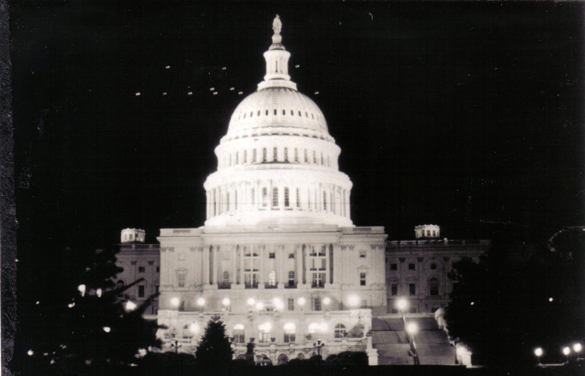
Image often mistaken for 1952 UFO encounter. The lights in the sky are actually reflections from the lights on the posts.
Ruppelt says this case convinced many that that UFOs were interplanetary spaceships.
If the objects over Washington DC in 1952 could not be explained, it seems obvious that an incursion of this sort would pose a threat to national security.
In the government’s UFO files there is a memo that claims the cases that posed a real threat were not included in the Blue Book files, and researchers have been tracking where those cases went.
They have discovered that the U.S. Air Force has taken UFO incidents seriously after the closing of Blue Book in 1969. And the cases that made it to this high-level reporting system are even more fascinating and alarming than the events in 1952.
We’ll take a look at this reporting system and the cases that have been discovered to have prompted its use in the next episode of Open Minds UFO Magazine.
To find out more about the experts in the video:
John Alexander: JohnBAlexander.com
Nick Pope: NickPope.net
Paul Dean: UFOs-Documenting-The-Evidence-Blogspot.com
http://www.openminds.tv/the-beginning-ufo-encounters-over-washington-d-c/38413
If the objects over Washington DC in 1952 could not be explained, it seems obvious that an incursion of this sort would pose a threat to national security.
In the government’s UFO files there is a memo that claims the cases that posed a real threat were not included in the Blue Book files, and researchers have been tracking where those cases went.
They have discovered that the U.S. Air Force has taken UFO incidents seriously after the closing of Blue Book in 1969. And the cases that made it to this high-level reporting system are even more fascinating and alarming than the events in 1952.
We’ll take a look at this reporting system and the cases that have been discovered to have prompted its use in the next episode of Open Minds UFO Magazine.
To find out more about the experts in the video:
John Alexander: JohnBAlexander.com
Nick Pope: NickPope.net
Paul Dean: UFOs-Documenting-The-Evidence-Blogspot.com
http://www.openminds.tv/the-beginning-ufo-encounters-over-washington-d-c/38413